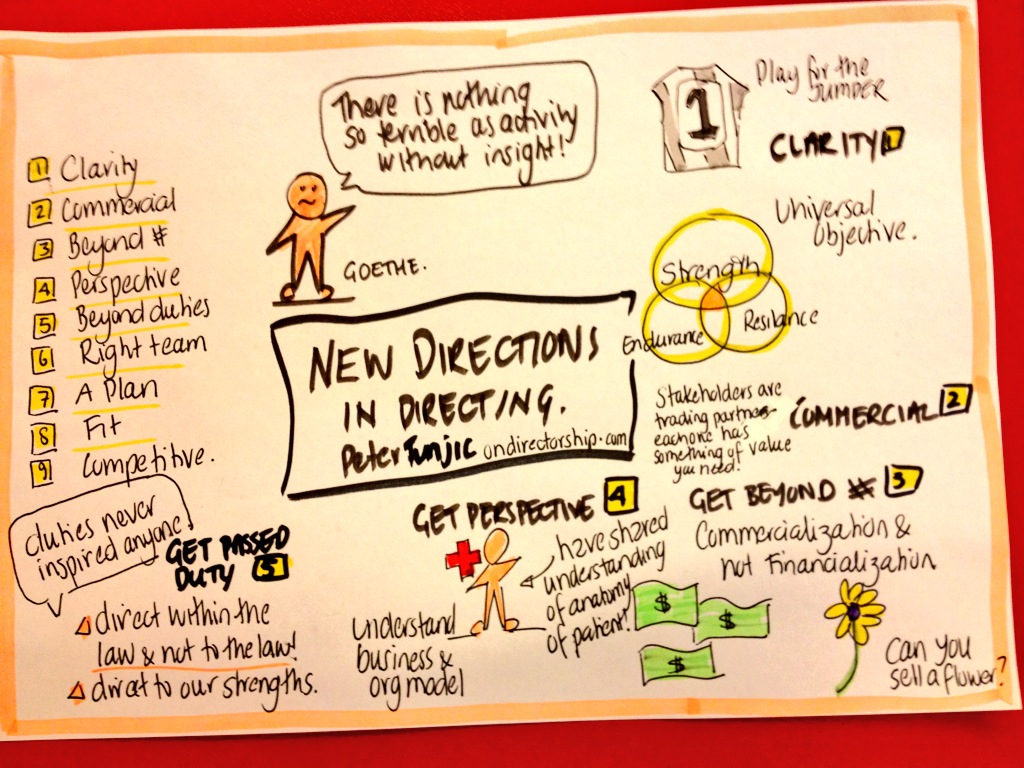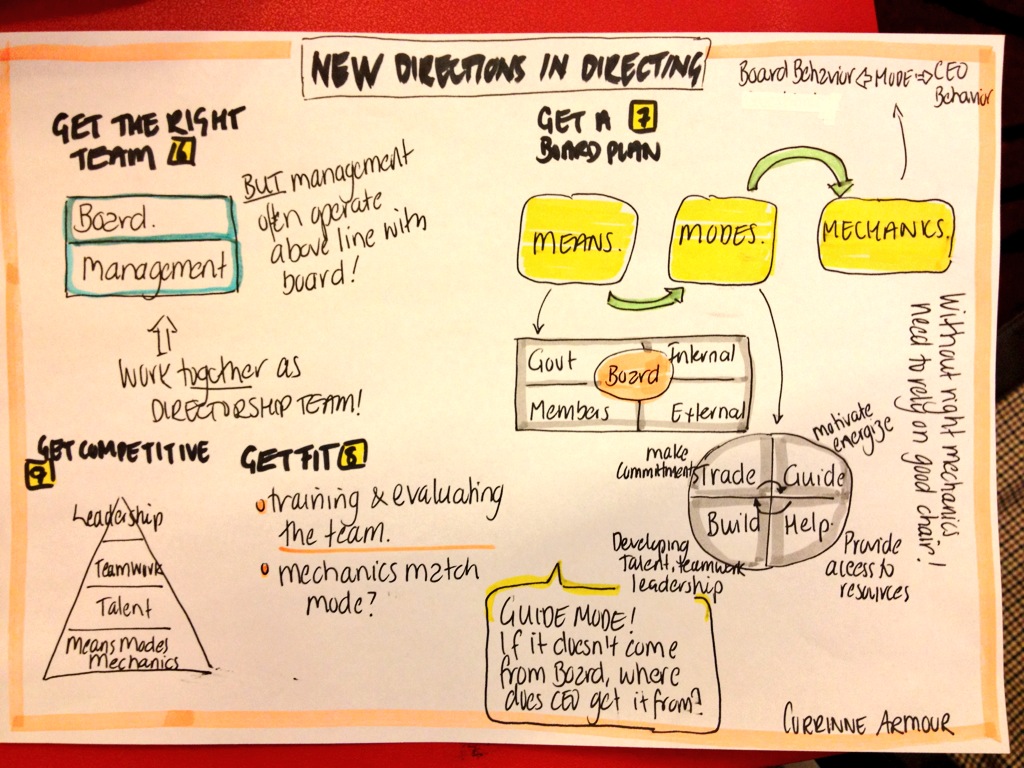New Directions in Directing - Sketches and Summary
I spoke at Australia's premier non profit conference for leaders and directors over the weekend. More information on the conference here.
Corrinne Armour captured the spirit of the event in a series of great sketches available for download at http://extraordinaryfuture.com.au/newsflash.
Here's her visual notes on my presentation, New Directions in Directing:
click on the image for the full gallery.
For those who prefer words here's the short paper that accompanied my talk.
“Nothing destroys the spirit of an organization faster than focusing on peoples weaknesses rather than on their strengths, building on disabilities rather than abilities. The focus must be on strength…the greatest mistake is to try to build on weakness”
Peter Drucker
Today’s boardrooms are increasingly governed for weakness. Many directors no longer direct their organisation into strength but monitor and cross examine their management out of fear and an unchallenged acceptance of a failing model of corporate governance.
This must stop.
Experts and regulators cannot be allowed to fashion the boardroom through their distorted vision that focuses on individual and organizational weakness. We must build a new vision for the boardroom that concentrates on what directors can do to foster the strength, resilience and endurance of the organisation.
To stop governing for weakness and start directing for strength consider these 9 innovative steps:
Step 1: Get Clarity
An organisation is a separate legal person. It has personal/individual sovereignty and owes nothing to any person that it has not promised.
An organisations' objective is to survive and grow in its own right. Start measuring for:
Strength (S)
Strength is a measure of intrinsic value created by trading through the best possible business model.
Resilience (R)
Resilience is a measure of the organisations' ability to make and keep the best possible promises.
Endurance (E)
The stronger and more resilient an organisation the longer it is able to fulfill its purpose.
Whatever an organisation’s individual and unique purpose, they all share the same S.R.E objective.
Step 2: Get Commercial and Committed
Whether for profit or not, all organisations rely on trade and their commitments for S.R.E. Commercial is just another word for sustainable.
Get commercial by:
calling "Stakeholders" what they really are TRADING PARTNERS
exchanging the best possible promises with all TRADING PARTNERS
prioritizing TRADING PARTNERS based on their contribution to S.R.E
making the BEST RISKS
Learn to direct by commitments to your organisation’s members, each other, the state, your employees and all other TRADING PARTNERS.
Step 3: Get Beyond the Numbers
Get beyond numbers by focusing on assets then cash. Seek out and understand your organisation’s assets and ask whether they are both valued and valuable to your trading partners.
Step 4: Get Perspective
No board can trade blind. Boards must work from business models and trading frameworks then financial models.
Financial literacy is pointless if a director cannot read the business model from which it is derived.
Every director must share an understanding of how the organisation works and how best to trade its assets. You can’t imagine a team of surgeons having their own opinion of a patient’s anatomy, so why accept each director having a personal view of their organisation.
Step 5: Get Past Duties
Aim for S.R.E. Personal duty sets the bar too low. Direct within the law but not too the law.
Step 6: Get a Third Team
Boards do not direct alone. Everyone knows there is a line that divides the board and management. What we don't realise is that for some of the time they’re on the same side of the line and need a plan to work together.
Directors are part of the “Third Team” made up of the board, the CEO, the executive and others. The Third Team is vital to an organisation’s success and arguably the most neglected and misunderstood.
Step 7: Get on Board with Mechanics and a Plan
All teams needs need team rules. Rules are the mechanics that connect the Third Team to an organisation’s S.R.E.
Get Strategic
To realise an organisation’s S.R.E directors must be strategic in the way they spend their time and energy. Deliberately choose when to guide and motivate, when to commit, when to help and finally when to build and develop the board and the rest of the Third Team.
These are the four “Modes of Directing”. Switch the Mode of Directing to match the organisation’s circumstances and realise your board’s potential.
Get Tactical
Shakespeare wrote “all the world’s a stage, and all men and women merely players. They have their exits and entrances, and one man in his time plays many parts”.
So it is with the board and the Third Team. Every member of the Third Team has a different part to play depending on the Mode of Directing. The key is to adapt roles, behaviours and tasks to ensure everyone is aligned. Fail to adapt and you will break the mechanics.
Step 8: Get Fit
Get fit by:
Testing for broken mechanics in your Third Team. What you think is a personality problem is probably broken mechanics.
Learning and practicing the right mechanics. My steps won’t fit into an orthodox worldview. You’ll need learn and adapt before you can put my steps into practice.
Step 9: Get Competitive
Get competitive by:
Forgetting most practiced corporate governance. It was never designed for the not profit sector and, if you look at the evidence, much of what passes for best practice doesn’t work.
Focusing on S.R.E
Using mechanics to develop a unique plan for your Third Team
Building the talent, teamwork and leadership to execute on the plan
Remember talent and diversity is not a strategy. No amount of talent will save a Board who’s only plan is to watch in fear.
It’s your choice to take these steps and set out in a new direction or continue down your current path. As James McRitchie explains:
"Unlike the natural sciences, where paradigms are used to explain and predict, corporate governance is socially constructed. Paradigms in our discipline are normative models, used to discipline and guide. The major stumbling block to shifting paradigms is recognizing the element of choice. We aren’t stuck with what we have. We can choose to move to a whole new paradigm, if it offers a better foundation for building the kind of world we want."
What kind of boardroom do you want? One governed for weakness or directed for strength?


